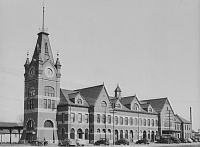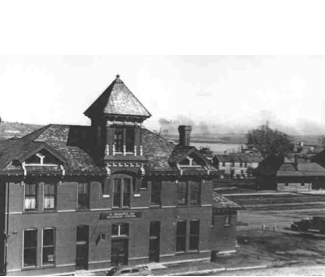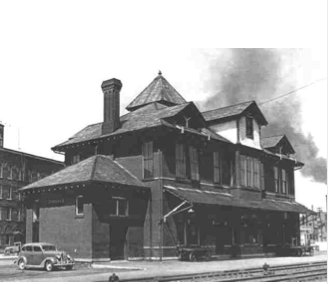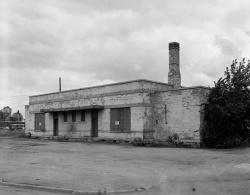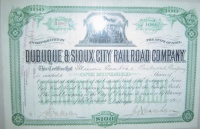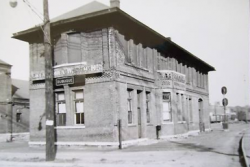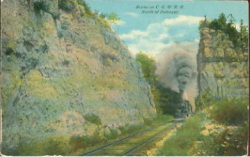Encyclopedia Dubuque
"Encyclopedia Dubuque is the online authority for all things Dubuque, written by the people who know the city best.”
Marshall Cohen—researcher and producer, CNN
Affiliated with the Local History Network of the State Historical Society of Iowa, and the Iowa Museum Association.
RAILROADS
RAILROADS. The passage on September 20, 1850, of the Illinois Central Land Grant by the United States Congress provided the first grant of public lands to assist in the construction of railroads. (1) This law led to the passage of the Iowa Land Grant Act and eventually the construction of the ILLINOIS CENTRAL RAILROAD between Dubuque and Sioux City.
The passage of the Illinois Central Land Grant Act, a special concern of Senator George Wallace JONES included a provision that the railroad in Illinois should have a branch line to Dubuque. This fact, acclaimed in Iowa, led to hordes of settlers moving into eastern Iowa.
Shortly after the construction of the Illinois Central began in Illinois, Lucius Hart LANGWORTHY and Jesse P. FARLEY began plans for a transcontinental railroad westward from Dubuque to the Pacific Coast. This had been the dream of John PLUMB, Jr. as early as 1838.
A meeting in Dubuque on April 28, 1853, was held to organize the company. The name DUBUQUE AND PACIFIC RAILROAD was chosen with the company's capital stock fixed at $10 million. The company was formally incorporated on May 19, 1853. Besides Langworthy and Farley, those involved in the company included Asa HORR and Platt SMITH.
Although those who incorporated the railroad were men of great wealth, the immense amount of capital needed to fund the ambitious project required two years of fund raising. Construction bonds were sold as low as fifty cents on the dollar in some places. By 1855 enough capital had been raised to begin work.
The ceremonial first spade of dirt was turned on October 1, 1855. Anticipating a business boom, speculators doubled land prices in Dubuque almost overnight. The construction of the railroad fueled further immigration into Iowa. A report of the number of FERRYBOATS crossing the MISSISSIPPI RIVER to Dubuque from April 12 to July 5, 1856 recorded 812 families totaling 4,504 people. Dubuque hotels accommodated 865,045 travelers in 1855.
On September 10, 1856 a pot-bellied, wood-burning locomotive from New Jersey was ferried across the Mississippi. The "Jesse P. Farley," named for the president of the railroad's president arrived soon after and made its first trip to Dyersville on May 11, 1857. The track did not have rock ballast, so cordwood was used to firm the rail bed. Despite this, the engine jumped the rails three times on its first trip. (2) The time schedule was as follows: (3)
Dubuque to Julien..............60 minutes
Julien to Caledonia (Peosta)...26 minutes
Caledonia to Epworth...........40 minutes
Epworth to Farley..............28 minutes
Farley to Dyersville...........35 minutes
The first train entered Earlville, then boasting two houses, on September 22. The panic of 1857 came as a severe blow to the company. Nearly all of the land the company received--1,251,040 acres--was immediately sold or given to creditors at an estimated price of two dollars per acre. (4) By 1857 the company was almost entirely under the control of Abram S. Hewitt of New York due to its inability to pay interest on construction bonds. Trying to keep confidence in the project alive led the Dubuque and Pacific Railroad to publish Northern Iowa: Containing Hints and Information of Value to Emigrants, a wonderful example of boosterism describing Iowa's opportunities.
Nearly two years of inactivity came to an end when the thirty-two miles between Earlville and Independence were completed on December 12, 1859. Train service between Dubuque and Jesup, seventy-eight miles apart, was completed on March 2, 1860.
Shortly after the completion of the line to Jesup, the Dubuque and Pacific Company was forced into receivership by Morris K. Jesup, the largest creditor. Taking over the business, Jesup saw the company reorganized on August 13, 1860, as the DUBUQUE AND SIOUX CITY RAILROAD. Company reports stated that the railroad owned thirty-five flat cars, six passenger cars, sixty-five box cars, and four locomotives. The railroad reached Waterloo on March 11, 1861, where the arrival was acclaimed as an end to the long overland trips to Dubuque to sell goods and obtain supplies. Twenty days after its arrival in Waterloo, the railroad reached Cedar Falls.
As the sectional hostilities increased before the CIVIL WAR, railroads played an important role in strengthening the North. Southern states relied heavily on steamboats. Railroads in the North, however, pushed west. By providing markets for crops and livestock, railroads succeeded in converting the West into an economic satellite of the North. (5)
The start of the Civil War suspended further construction. For the next four years, Cedar Falls was the western terminus of the line. East of Dubuque, the Illinois Central and the Chicago and Galena railroads linked Dubuque with eastern cities.
The war had a marked effect on railroad transportation. Stalled shipments out of Dubuque by way of the Mississippi River led to stores of grain in Dubuque increasing faster than they could be shipped. Wartime use of the rails was further harmed after January 1865 when only government cars were given the right-of-way. Dubuque businessmen, feeling harassed, pledged $100,000 to the first railroad completing its track from Lake Michigan to Dubuque. The Julien Theater was the scene of a Shippers and Merchants Convention on March 1-2, 1865 which considered building another railroad eastward from Dubuque.
Railroad construction resumed with peace. By April 16, 1866, the DUBUQUE AND PACIFIC RAILROAD had reached Iowa Falls, 143 miles west of Dubuque. Business boomed freighting livestock to market and offering passenger service to immigrants headed west. (6) The Dubuque and Sioux City Railroad existed only on paper after 1867 when the Illinois Central leased the road. (7) In 1870 the Illinois Central joined the track to Sioux City. (8) The lease on the road ended in 1870 and the Illinois Central forced to Dubuque and Sioux City to sell its stock at $80 per share. (9)
The DUNLEITH AND DUBUQUE BRIDGE was completed in December 1869. (10) Considered an engineering triumph of the day, it was built by the Keystone Bridge Company headed by Andrew CARNEGIE. Regular train service from Chicago through Dubuque to Sioux City began on October 10, 1870.
Like the hub of a wheel, Dubuque became the center of intense railroad building. Railroad construction out of the city southward was the goal of the DUBUQUE, BELLEVUE, AND MISSISSIPPI RAILWAY. With forty thousand acres of land and $300,000, the company planned to lay track through Jackson and Clinton counties.
To the north, the Dubuque, the Saint Peter and Saint Paul Railroad joined with the Turkey River Valley Railroad Company. A projected route extended through Clayton, Fayette, and Howard counties into southern Minnesota. Although this promised valuable trade with Dubuque, the line was never constructed.
With the goal of reaching markets to the southwest, the DUBUQUE WESTERN RAILROAD planned to reach Anamosa. There it would link itself to the Iowa Central Air Line Railroad to connect Dubuque with trade in Benton, Boone, Jones, Linn, Tama and Marshall counties. Organized in September 1855, the company built an independent track from its depot yards through the northern city limits of Dubuque to the track belonging to the Dubuque and Pacific at Center Grove. The Dubuque Western, financed by a $200,000 private subscription, a loan of $200,000 voted by Dubuque residents, and a land grant, leased Dubuque and Pacific track to Farley Junction before building south. The Dubuque Western reached Anamosa by 1860. After consolidation and being renamed the Dubuque Southwestern Railroad, it pushed on toward Cedar Rapids.
To the northeast, the Dubuque and Waukegan and Dubuque, Arena, and Watertown promised Dubuque access to valuable forests of Wisconsin around Milwaukee and Green Bay.
The year 1867 was crucial in the history of Dubuque's railroads. Sioux City, hoping to challenge Council Bluffs and a "gateway to the West," pressured the Dubuque line to hurry construction of its track between Iowa Falls and Sioux City. This would enable Sioux City to link itself with the Union Pacific at Fremont, Nebraska, and thus beat Council Bluffs which hoped to be the link for the Chicago and Northwestern Railway and Union Pacific. At this point, the Illinois Central entered Iowa. The Dubuque and Sioux City line, lying between Dubuque and Iowa Falls, was leased to the Illinois Central on September 13, 1867, and a million dollar bridge, DUNLEITH AND DUBUQUE BRIDGE, was contracted.
Financing railroad construction was accomplished in part by the private issuance of notes from the railroad company. Examples of this in Dubuque include hand-dated notes issued by the Dubuque and Pacific Railroad Company; the DUBUQUE, MARION, AND WESTERN RAILROAD COMPANY; the Dubuque and Sioux City Railroad; and the Dubuque Western Railroad Company.
In 1883 the DUBUQUE AND NORTHWESTERN RAILROAD was organized, but stymied in its progress by misfortunes of two or three great railroads which depressed the value of its securities. Work was resumed in 1885 under the supervision of the Minnesota and Northwestern. The line ran in a northwest direction out of Dubuque through Buchanan, Fayette, Bremer, Chickasaw and Howard counties in Iowa and Mower and Dodge counties in Minnesota. It connected there with the Minnesota and Northwestern which operated between St. Paul and the Iowa line at Mona. The company had also purchased fifty acres at the northern end of Dubuque for its machine shops, transfer yard, car yard, and roundhouse. (11)
By the late 1800s, railroads had replaced steamboats as the primary means of transportation. This encouraged the development of cities away from rivers and near to interior sites of agriculture. Railroads like the Illinois Central advertised throughout eastern states and Europe to tell people land was available. Railroads even arranged passage for potential customers to view the land. Plans called for towns to develop in intervals from five to fifteen miles along the track. This was considered a reasonable distance to travel for farmers to bring products into town for shipment. (12) Towns established before railroads or those which did not comply with railroad requests could be by-passed. Some towns relocated or like Hanover, Illinois formed the Hanover Railway Company to construct a 2.5 mile track to the Chicago and Great Western Railroad lines.
Dubuque for years had direct connection with only two major railroad systems--the Illinois Central and the Chicago, Milwaukee and St. Paul--a total of about 7,000 miles. Dubuque by 1886 was part of an immense railroad network. The following chart indicated the number of miles of railroads entering Dubuque: (13)
Illinois Central 1,915
Chicago, Milwaukee and St. Paul 4,935
Chicago, Burlington and Northern 365
Chicago Burlington and Quincy 4,661
Dubuque and Dakota 64
Dubuque and Northwestern 141
Minnesota and Northwestern 109
Total 12,190
In September, 1885 M. C. Woodruff published a pamphlet entitled "The Industries of Dubuque." In it, he wrote that Dubuque received and shipped about one-twelfth of the entire freightage of the entire state of Iowa. (14) City officials were expecting in the near future that the Chicago and Northwestern system of 5,809 miles would extend its line to Dubuque and that the Minnesota and Northwestern and Dubuque and Northwestern would extend its line from Dubuque to Chicago. Upon such information, Woodruff concluded that "Dubuque's business promise for the future greatly exceeds the accomplished pre-eminence of the past." (15)
In August 1894 an ordinance was proposed forcing railroads to pay for street improvements where their tracks were located. This ordinance was in compliance with a law passed by the previous session of the Iowa legislature. (16) In 1904 the railroads assured the chief of police that they would respect the ordinance of not operating in the city limits in excess of six miles per hour. (17)
On December 3, 1917 a meeting of representatives of all railroads entering Dubuque was held. The topic of conversation was the potential consolidating all Dubuque passenger stations into one union station. Officials of the other lines generally agreed with officials of the Illinois Central that their station had the most suitable location for such a plan. The motivation for the change came from the federal government which in supervising the railroads demanded consolidation of assets. (18)
By WORLD WAR I Dubuque's railroads had reached a peak as did the growth of the city. By the 1930s narrow gauge railroads had been judged inadequate. Because they could not handle the freight of the standard gauge cars, an estimated two hundred miles of track was torn up by the start of WORLD WAR II and not replaced by larger track. The last of the small rails in Iowa belonging to the Bellevue and Cascade line were removed in 1934. (19)
Factors leading to declining railroads nationwide as well as in Dubuque included trucking and private automobiles, government taxes and labor. In 1930 it was estimated that the amount of intercity travel by automobile was less than 50%. By 1959 it was estimated at 90%. Railroads which saw its passenger service fail to pay for itself by 1920 reduced their number of passenger cars. In 1909 there were twelve passenger trains leaving Dubuque daily for Chicago. In 1959 only two of the four Dubuque railroads provided passenger coaches. (20) Railroads were also once the primary transport system of fruit and express deliveries; by 1959 trucks were carrying 65% of these products. (21)
Responding to these challenges, railroads reduced branch lines and employees, began freighting trucks, modernized equipment, and appealed to the government for tax relief. Between 1926 and 1959, railroads reduced the number of employees by 50%. Railroads began buying their own trucks. Hauling these semi-trailers on flat railroad cars became the "piggyback" system. One Dubuque depot constructed a ramp needed to pull the trailers from the flat cars. Several Dubuque trains substituted in favor of train schedules. Trucks owned by railroads drove from Dubuque to Waterloo and Rockford daily. The first step in streamlining trains were the first zephyrs in the mid-1930s. Vista-domes were introduced in 1945 to encourage tourists. (22)
In 1988 the progress of U. S. 61 through Dubuque was dependent upon an agreement to abandon part of the Soo Line track--in the planned U. S. 61 right-of-way--for merger with the Chicago, Central and Pacific railroads. Parties to the agreement included the Department of Transportation, the Soo Line and the Chicago, Central and Pacific railroads. (23)
Research is still being done on the ST. PAUL AND DUBUQUE RAILROAD COMPANY which it is believed became part of the DUBUQUE AND NORTHWESTERN RAILROAD.
---
Source:
1. "Illinois Central Railroad" (Corporate History), Encyclopedia of Chicago, Online: http://www.encyclopedia.chicagohistory.org/pages/2716.html
2. "Dubuque's $10 Million Railroad Was Vital Link With Early West," Telegraph Herald, September 2, 1962, p. 20
3. Ibid.
4. Ibid.
5. Ibid.
6. Ibid.
7. Illinois Central Historical Society. Online: http://www.icrrhistorical.org/milestones.html
8. "Dubuque's $10 Million..."
9. Ibid.
10. Illinois Central Historical Society
11. "Dubuque's Railroads," The Herald, May 9, 1886, p. 1
12. Sisco, Becky and John Everly,"Towns Formed, Thrived Near Railroads," Telegraph Herald, September 28, 2001, p. 1
13. "Dubuque's Railroads,"
14. Ibid.
15. Ibid.
16. "New Railway Lines," The Herald, December 31, 1899, p. 4. Online: http://p8080-10.30.40.140.ezproxy.dubuque.lib.ia.us/ResCarta-Web/jsp/RcWebImageViewer.jsp?doc_id=76d75574-3467-4ecf-9df4-c2b7da149f1e/ResCarta/00000002/00001465
17. "A New Ordinance," Dubuque Daily Herald, August 10, 1894, p. 4
18. "Want Compromise," Dubuque Telegraph-Herald, January 28, 1904, p. 3
19. Stevens, Dave."Railroading in Transition," The Telegraph-Herald, November 15, 1959, p. 17
20. Ibid.
21. Ibid.
22. Ibid.
23. Gallo, Matt, "Rail Deal Predicted in 60 ," Telegraph Herald, September 2, 1988, p. 1


